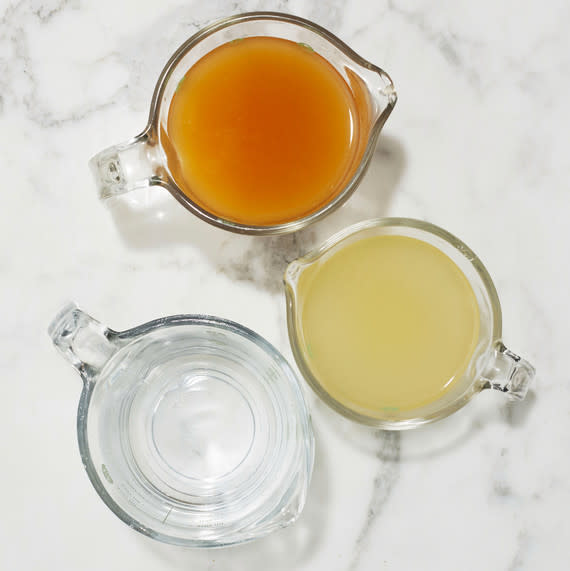Is Broth the Same as Stock?

Every soup, stew, and many sauces require broth or stock. They add a depth of flavor and are the base of recipes as diverse as split-pea soup, chicken pot pie, and fish stews like Cioppino. They even look similar, so what's the difference between stock and broth? Can you substitute one for the other? And when should you use each?
Related: Follow These Rules for Making the Best Vegetable Soup
What's the Difference Between Stock and Broth?
The main difference between the two is that stock is made with the bones of an animal (chicken, beef, fish, or veal are the most common) and broth is made with the meat, not the bones, of the animal. A robust, flavorful stock (known as a brown stock in classical French cooking) begins by roasting bones and mirepoix (celery, carrots, and onions); some stock recipes recommend rubbing the bones and vegetables with a tablespoon of tomato paste for added flavor and color. Because stock is made with bones, which have high amounts of collagen, it tends to be richer and fattier than broth—it also takes longer to make than broth. Of course, there's an exception to every rule: Vegetable broth and vegetable stock are the same thing (vegetables and herbs cooked in water to extract flavor).
Despite the differences between stock and broth, the terms are often used interchangeably. Traditionally, stock was unseasoned and broth was seasoned, since broth was often consumed as-is in a soup, and stock was typically enhanced with other ingredients. You can substitute stock for broth, and vice versa, but may need to adjust seasoning accordingly.
When to Cook with Stock and Broth
Beef stock is often used as the base of French Onion Soup, it gives the soup its signature dark brown color and robust flavor. Veal stock is the base of French bordelaise sauce, a rich and glossy sauce served with steaks and short ribs. Chicken stock is used in many recipes, from noodle soup to stuffing.
Broth is best used as a delicate base for soups including Tortellini Soup, Turkey-Pesto Meatball Soup, and Broken Wonton Soup. Dashi, is a Japanese broth, is made by boiling kombu seaweed and bonito flakes for a briny flavor that serves as the base of miso soup. Vietnamese Pho, is also made with a light, aromatic beef broth that gives flavor to this rice noodle soup.
Why Making Stock and Broth Is Best
While there are plenty of store-bought options, it's easy and relatively inexpensive to make your own chicken stock or vegetable broth. Save vegetable scraps and chicken, meat, or fish bones in freezer bags and freeze them until you have enough to make stock or broth. Make a big batch and store it in airtight containers in the freezer, ready to use whenever you need it over the coming months. Not only will you reduce waste, you'll also save money.
What's the Deal with Bone Broth?
Bone broth has been trending in recent years thanks to health claims that it fights inflammatory diseases, improves digestion and, you guessed it, bone health. Despite its name, the process for making bone broth is more like making stock; animal bones are roasted, then simmered for several hours, or up to an entire day. The proteins and collagen found in animal bones infuse the liquid with nutrients, which we then drink and absorb.
